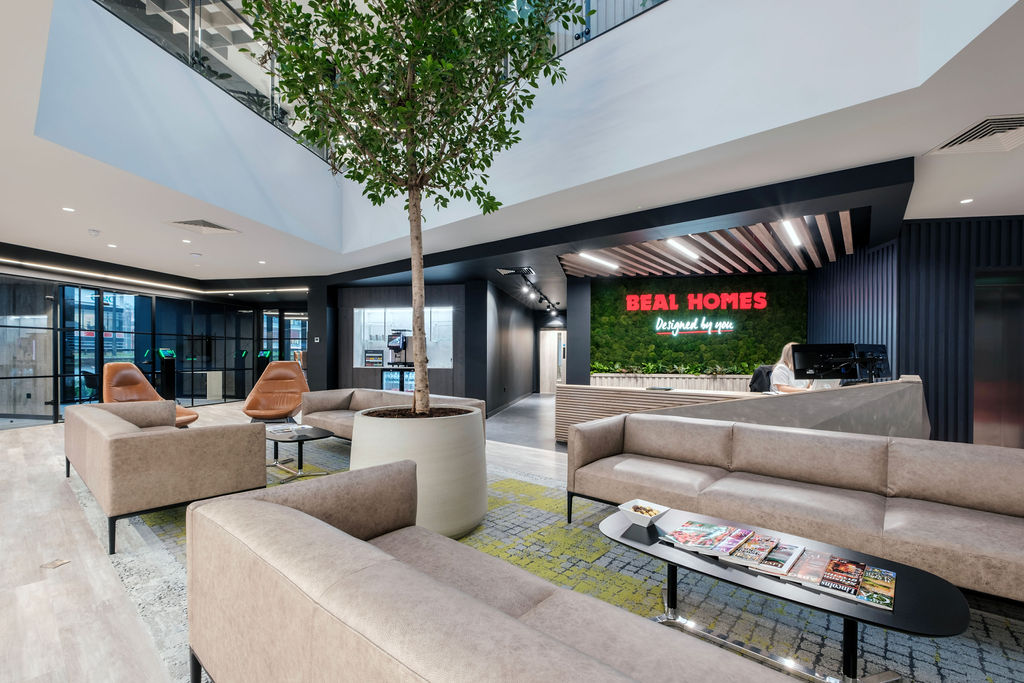
Industry Insight
The Emotion of Space: Building Brand Identity Through Design

Biophilic design draws its essence from the term “biophilia,” which reflects the intrinsic connection humans share with the natural world. It encompasses the innate yearning to be in close proximity to nature—a relationship woven into our evolutionary history. Biophilic design seeks to emulate this connection by integrating natural elements into our built environment, bridging the gap between urban spaces and the great outdoors.
The modern workplace is often characterised by concrete walls, artificial lighting, and minimal access to greenery. Biophilic design disrupts this status quo by introducing elements that echo the natural world. From potted plants and living walls to the use of natural materials, these elements restore a sense of balance and tranquillity that fosters a healthier work atmosphere.
Studies have illuminated the cognitive benefits of biophilia in the workplace. Exposure to nature-inspired design has been linked to improved cognitive function, including enhanced concentration, problem-solving skills, and creative thinking. These attributes are not just desirable; they are crucial in a dynamic and rapidly evolving work environment.
Biophilic design has the power to alleviate stress, a pervasive concern in today’s high-pressure workplaces. The incorporation of natural elements has been shown to lower cortisol levels and promote relaxation. These stress-reducing effects contribute to better mental health, reduced absenteeism, and increased job satisfaction among employees.
Ample natural light is a cornerstone of biophilic design. Position workstations near windows to harness natural daylight, which not only reduces energy costs but also enhances employee mood and circadian rhythms.
Indoor plants bring life and vitality to office spaces. Integrate a variety of plants, from potted ferns and succulents to larger statement plants, creating a vibrant and refreshing atmosphere.
Opt for furniture and decor crafted from natural materials like wood, stone, and bamboo. These materials not only connect employees to nature but also add a touch of warmth and authenticity to the workspace.
Create designated relaxation areas adorned with nature-inspired elements. Comfortable seating, soft lighting, and strategically placed plants offer employees a peaceful retreat within the bustling office environment.
A workspace that values well-being resonates deeply with employees. Biophilic design signals to the workforce that their comfort and health are paramount, leading to heightened employee engagement, loyalty, and reduced turnover rates.
Biophilic design contributes to an aesthetically pleasing office that impresses clients and visitors. The incorporation of nature-infused elements reflects positively on your brand, projecting an image of innovation and care.
Biophilic design aligns seamlessly with sustainability goals, as it promotes the use of natural materials and reduces energy consumption. Embracing biophilia demonstrates a commitment to corporate responsibility and environmental stewardship.
Creating a biophilic workspace demands thoughtful planning, expert execution, and an understanding of how to weave natural elements into the fabric of the office environment. We specialise in translating the principles of biophilic design into practical and transformative solutions for your office space.
By partnering with us, you unlock the potential of a workplace that transcends the ordinary. Our experienced team of designers is dedicated to crafting environments that celebrate the beauty of biophilia, enhancing employee well-being, and propelling your business toward greater success.
Biophilic design stands as a testament to the profound impact nature has on human psychology, productivity, and well-being. Beyond its aesthetic allure, it is a dynamic philosophy that has found its way into the heart of contemporary office spaces, revolutionising the way we experience work.
As the corporate landscape evolves, prioritising employee health and happiness becomes a strategic advantage. Biophilic design is more than a trend; it’s an investment in a brighter, more harmonious future for both businesses and their most valuable assets—people.
Discover the potential of biophilic design. Let us guide you on a journey to reimagine your office space, forging a stronger connection between nature and work, and igniting a new era of productivity and prosperity.